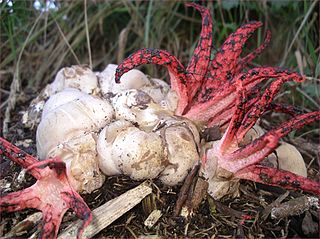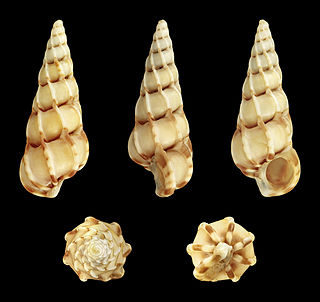
The great crested grebe is a member of the grebe family of water birds. The bird is characterised by its distinctive appearance, featuring striking black and white plumage, and elaborate courtship display that involves synchronised dances and displays.

The crested tit or European crested tit, is a passerine bird in the tit family Paridae. It is a widespread and common resident breeder in coniferous forests throughout central and northern Europe and in deciduous woodland in France and the Iberian peninsula. In Great Britain, it is chiefly restricted to the ancient pinewoods of Inverness and Strathspey in Scotland, and seldom strays far from its haunts. A few vagrant crested tits have been seen in England. It is resident, and most individuals do not migrate.

Phallaceae is a family of fungi, commonly known as stinkhorns, within the order Phallales. Stinkhorns have a worldwide distribution, but are especially prevalent in tropical regions. They are known for their foul-smelling, sticky spore masses, or gleba, borne on the end of a stalk called the receptaculum. The characteristic fruiting-body structure, a single, unbranched receptaculum with an externally attached gleba on the upper part, distinguishes the Phallaceae from other families in the Phallales. The spore mass typically smells of carrion or dung, and attracts flies, beetles and other insects to help disperse the spores. Although there is great diversity in body structure shape among the various genera, all species in the Phallaceae begin their development as oval or round structures known as "eggs". The appearance of Phallaceae is often sudden, as gleba can erupt from the underground egg and burst open within an hour. According to a 2008 estimate, the family contains 21 genera and 77 species.

The brown shrike is a bird in the shrike family that is found mainly in Asia. It is closely related to the red-backed shrike and isabelline shrike. The genus name, Lanius, is derived from the Latin word for "butcher", and some shrikes are also known as "butcher birds" because of their feeding habits. The specific cristatus is Latin for "crested", used in a broader sense than in English. The common English name "shrike" is from Old English scríc, "shriek", referring to the shrill call.

The Indian peafowl, also known as the common peafowl, and blue peafowl, is a peafowl species native to the Indian subcontinent. It has been introduced to many other countries. Male peafowl are referred to as peacocks, and female peafowl are referred to as peahens, although both sexes are often referred to colloquially as a "peacock".

The marine iguana, also known as the sea iguana, saltwater iguana, or Galápagos marine iguana, is a species of iguana found only on the Galápagos Islands (Ecuador). Unique among modern lizards, it is a marine reptile that has the ability to forage in the sea for algae, which makes up almost all of its diet. Marine iguanas are the only extant lizard that spends time in a marine environment. Large males are able to dive to find this food source, while females and smaller males feed during low tide in the intertidal zone. They mainly live in colonies on rocky shores where they bask after visiting the relatively cold water or intertidal zone, but can also be seen in marshes, mangrove swamps and beaches. Large males defend territories for a short period, but smaller males have other breeding strategies. After mating, the female digs a nest hole in the soil where she lays her eggs, leaving them to hatch on their own a few months later.

Cynosurus cristatus, the crested dog's-tail, is a short-lived perennial grass in the family Poaceae, characterised by a seed head that is flat on one side. It typically grows in species rich grassland. It thrives in a variety of soil types but avoids the acid and calcareous extremes of pH, and prefers well drained soils. It may be grown as an ornamental plant.

Clathrus is a genus of fungi of the family Phallaceae, the stinkhorn fungi. Mature fruit bodies are covered with olive-brown slimy gleba, containing spores, that attract flies. These fungi are saprobic and are common in mulch.

Clathrus archeri, commonly known as octopus stinkhorn or devil's fingers, is a fungus which has a global distribution. This species was first described in 1980 in a collection from Tasmania. The young fungus erupts from a suberumpent egg by forming into four to seven elongated slender arms initially erect and attached at the top. The arms then unfold to reveal a pinkish-red interior covered with a dark-olive spore-containing gleba. In maturity it smells like putrid flesh.

Clathrus ruber is a species of fungus in the family Phallaceae, and the type species of the genus Clathrus. It is commonly known as the latticed stinkhorn, the basket stinkhorn, or the red cage, alluding to the striking fruit bodies that are shaped somewhat like a round or oval hollow sphere with interlaced or latticed branches. The species was illustrated in the scientific literature during the 16th century, but was not officially described until 1729.

Clathrus columnatus, commonly known as the column stinkhorn, is a saprobic species of basidiomycete fungus in the family Phallaceae. Similar to other stinkhorn fungi, the fruiting body, known as the receptaculum, starts out as a subterranean "egg" form. As the fungus develops, the receptaculum expands and erupts out of the protective volva, ultimately developing into mature structures characterized by two to five long vertical orange or red spongy columns, joined at the apex. The fully grown receptaculum reaches heights of 8 cm tall. The inside surfaces of the columns are covered with a fetid olive-brown spore-containing slime, which attracts flies and other insects that help disseminate the spores.

Epitonium clathrus, also known as the common wentletrap, is a species of small predatory sea snail, a marine gastropod mollusc in the family Epitoniidae, the wentletraps.
Ascandra contorta is a species of calcareous sponge belonging to the family Clathrinidae.

Clathrus bicolumnatus is a species of fungus in the stinkhorn family. It is known only from Japan.

Clathrus chrysomycelinus is a species of fungus in the stinkhorn family. It is found in South America and reported from New Zealand, although the equivalence of the species is yet to be determined.

Clathrus crispus is a species of fungus in the stinkhorn family. Reported as new to science in 1820, it is found in the Americas.
Clathrus kusanoi is a species of fungus in the stinkhorn family. It is known only from Japan.
Clathrus mauritianus is a species of fungus in the stinkhorn family. It is found in Mauritius.

Clathrus transvaalensis is a species of fungus in the stinkhorn family. It is found in South Africa. It was described as new to science in 1990 by mycologists Albert Eicker and Derek Reid. The fruit body forms a hollow, pale yellow to pinkish lattice structure.

Clathrus treubii is a species of fungus in the stinkhorn family. It is found in Indonesia and Malaysia.















